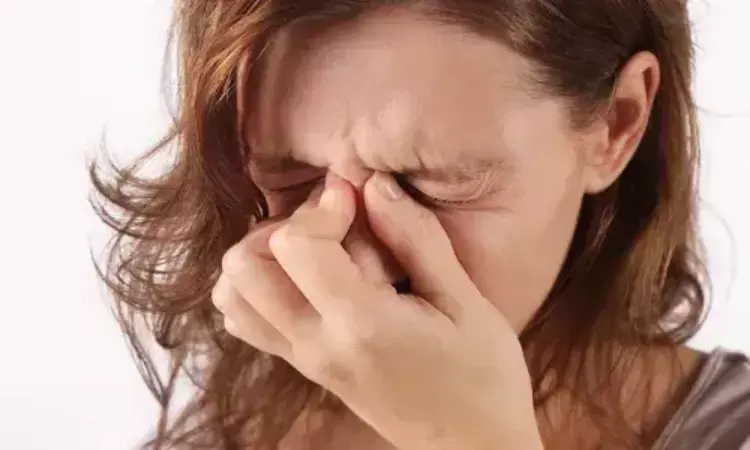- Home
- Medical news & Guidelines
- Anesthesiology
- Cardiology and CTVS
- Critical Care
- Dentistry
- Dermatology
- Diabetes and Endocrinology
- ENT
- Gastroenterology
- Medicine
- Nephrology
- Neurology
- Obstretics-Gynaecology
- Oncology
- Ophthalmology
- Orthopaedics
- Pediatrics-Neonatology
- Psychiatry
- Pulmonology
- Radiology
- Surgery
- Urology
- Laboratory Medicine
- Diet
- Nursing
- Paramedical
- Physiotherapy
- Health news
- Fact Check
- Bone Health Fact Check
- Brain Health Fact Check
- Cancer Related Fact Check
- Child Care Fact Check
- Dental and oral health fact check
- Diabetes and metabolic health fact check
- Diet and Nutrition Fact Check
- Eye and ENT Care Fact Check
- Fitness fact check
- Gut health fact check
- Heart health fact check
- Kidney health fact check
- Medical education fact check
- Men's health fact check
- Respiratory fact check
- Skin and hair care fact check
- Vaccine and Immunization fact check
- Women's health fact check
- AYUSH
- State News
- Andaman and Nicobar Islands
- Andhra Pradesh
- Arunachal Pradesh
- Assam
- Bihar
- Chandigarh
- Chattisgarh
- Dadra and Nagar Haveli
- Daman and Diu
- Delhi
- Goa
- Gujarat
- Haryana
- Himachal Pradesh
- Jammu & Kashmir
- Jharkhand
- Karnataka
- Kerala
- Ladakh
- Lakshadweep
- Madhya Pradesh
- Maharashtra
- Manipur
- Meghalaya
- Mizoram
- Nagaland
- Odisha
- Puducherry
- Punjab
- Rajasthan
- Sikkim
- Tamil Nadu
- Telangana
- Tripura
- Uttar Pradesh
- Uttrakhand
- West Bengal
- Medical Education
- Industry
Long-Term PM2.5 Exposure Linked to Increased Risk of Nasal Polyps in Chronic Rhinosinusitis: Study Finds

USA: In a recent exposure-matched study, researchers found that long-term exposure to fine particulate matter (PM2.5) may significantly increase the risk of developing chronic rhinosinusitis with nasal polyposis (CRSwNP), highlighting the potential role of air pollution in upper airway inflammatory diseases.
The analysis, published in the International Forum of Allergy & Rhinology, revealed that individuals with higher PM2.5 exposure had over seven times greater odds of developing CRSwNP (OR 7.22). Additionally, control participants exposed to elevated PM2.5 levels exhibited reduced interleukin-10 (IL-10) levels (β −0.735), a key anti-inflammatory cytokine. Interestingly, this association was not observed in patients with CRS without nasal polyps, suggesting a possible specific link between PM2.5 exposure and the development of nasal polyps.
Particulate matter ≤2.5 µm in diameter has emerged as a potential contributor to chronic rhinosinusitis (CRS) by promoting upper airway inflammation. Prior studies have indicated that PM2.5 exposure may shift the nasal mucosa toward a Type 2 inflammatory response, commonly seen in CRS with nasal polyposis (CRSwNP).
Building on this, Naweed I. Chowdhury from the Department of Otolaryngology—Head and Neck Surgery at University of Alabama at Birmingham, Birmingham, AL, and colleagues explored whether long-term PM2.5 exposure is specifically linked to CRSwNP rather than non-polyp CRS. With limited comparative data on cytokine changes in CRS and non-CRS patients, the study hypothesized that chronic exposure may selectively increase the risk of polyp formation.
For this purpose, the researchers analyzed data from 376 patients (308 with CRS and 68 controls) who underwent sinus or skull base surgery. A machine-learning model estimated daily PM2.5 exposure for the year before surgery. Cytokine levels were measured and correlated with PM2.5 exposure using Spearman and multivariate analyses. High- and low-exposure groups were matched by age, sex, income, and rurality. Logistic regression was used to assess the odds of CRS based on PM2.5 exposure.
The key findings of the study were as follows:
- Higher PM2.5 exposure was significantly associated with reduced IL-10 levels in control patients (β = −0.735).
- In the exposure-matched logistic regression analysis, elevated 12-month PM2.5 exposure independently predicted CRSwNP (β = 1.97, OR: 7.22) after adjusting for age, income, rurality, and comorbid asthma/allergic rhinitis.
- There was no significant association between PM2.5 exposure and CRSsNP.
The findings reinforce the role of PM2.5 as an independent risk factor for developing chronic rhinosinusitis with nasal polyposis, with the associated risk comparable to that posed by comorbid asthma or allergic rhinitis. Notably, reduced levels of IL-10—a key anti-inflammatory cytokine—were observed in control patients exposed to higher levels of PM2.5, suggesting a potential mechanistic link between prolonged particulate matter exposure and increased vulnerability to nasal mucosal inflammation.
"While these findings highlight a possible pathway contributing to CRSwNP, further validation through experimental, in vitro, and longitudinal multi-omics studies is warranted," the authors concluded.
Reference:
Lubner, R. J., Krysinski, M., Li, P., Chandra, R. K., Turner, J. H., & Chowdhury, N. I. Long-Term Particulate Matter Exposure May Increase Risk of Chronic Rhinosinusitis WIth Nasal Polyposis: Results from an Exposure-Matched Study. International Forum of Allergy & Rhinology, e23589. https://doi.org/10.1002/alr.23589
Dr Kamal Kant Kohli-MBBS, DTCD- a chest specialist with more than 30 years of practice and a flair for writing clinical articles, Dr Kamal Kant Kohli joined Medical Dialogues as a Chief Editor of Medical News. Besides writing articles, as an editor, he proofreads and verifies all the medical content published on Medical Dialogues including those coming from journals, studies,medical conferences,guidelines etc. Email: drkohli@medicaldialogues.in. Contact no. 011-43720751


